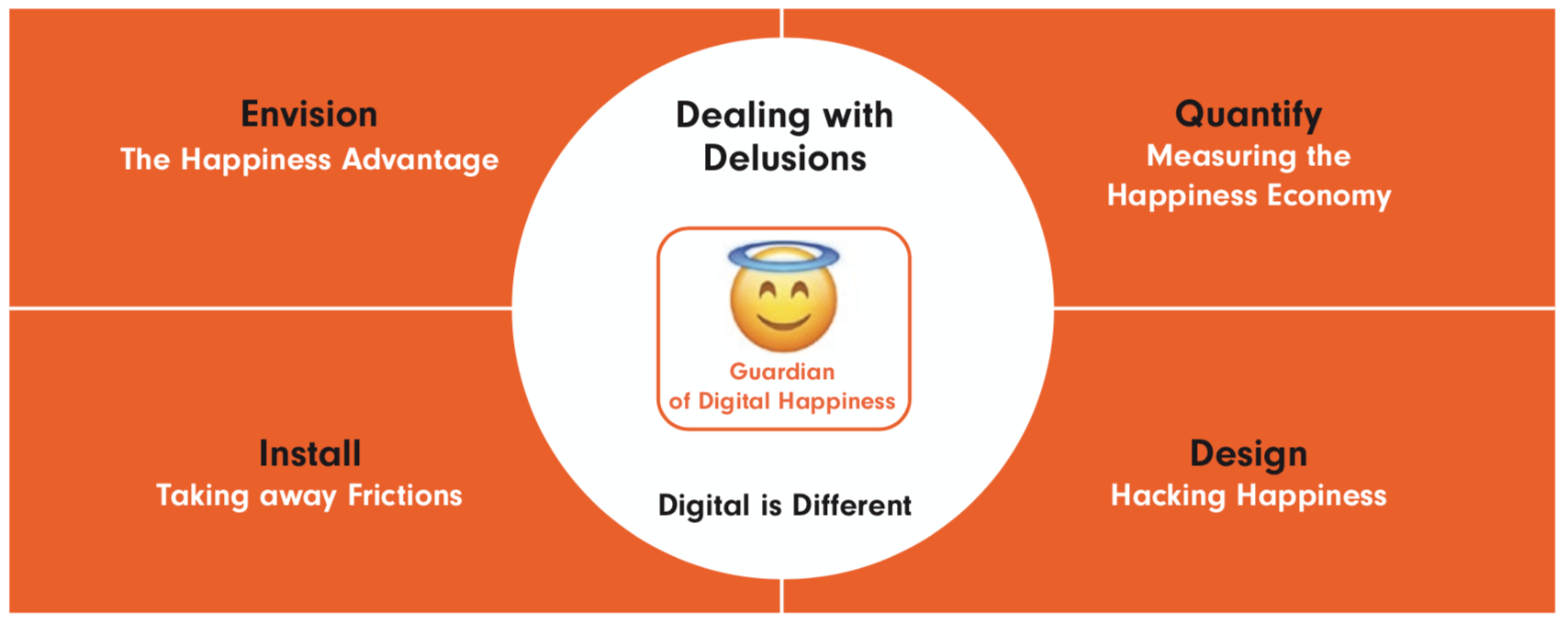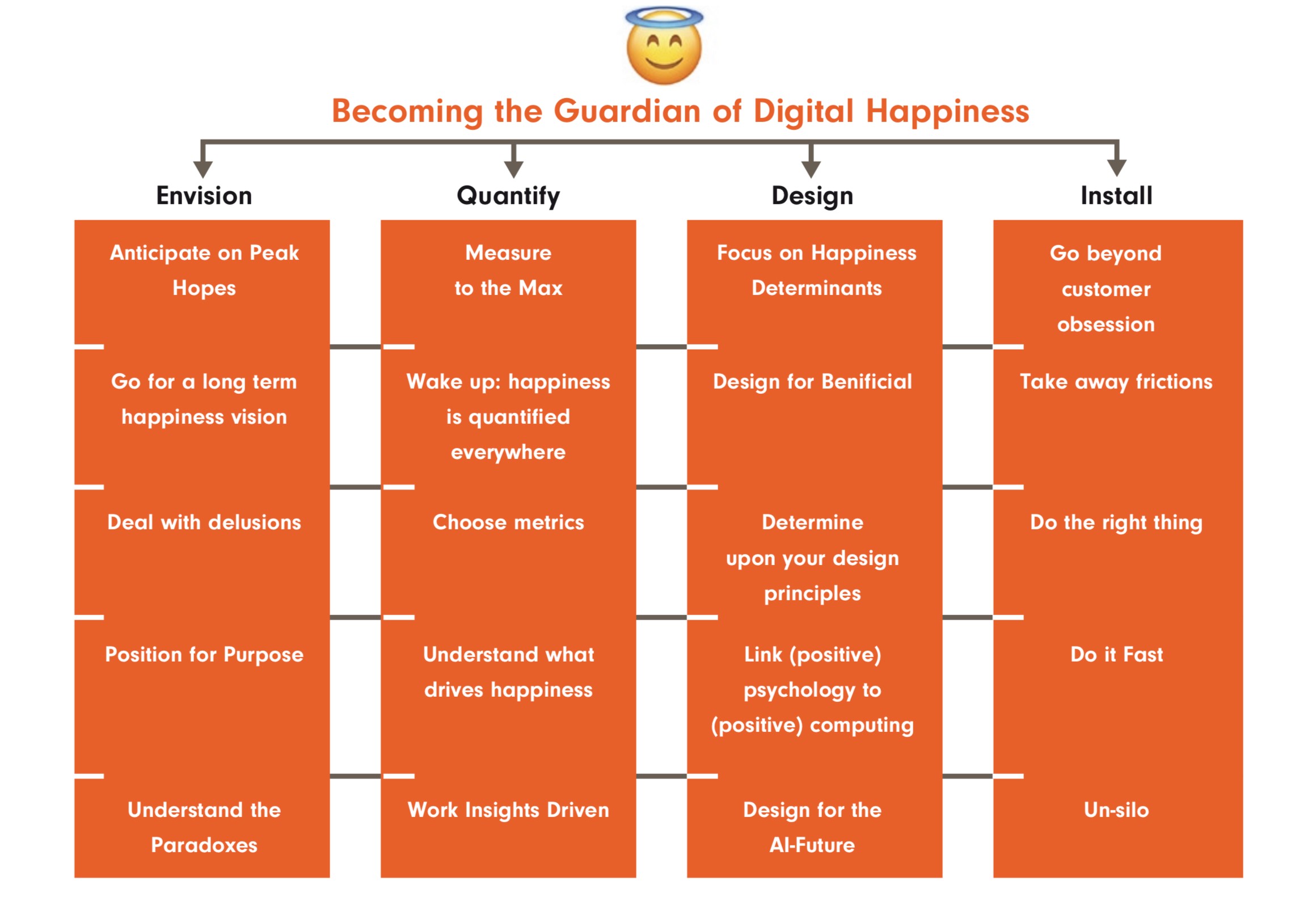4 Ways to Gain the ‘Happiness’ Competitor Advantage
The ability for digital to create happiness is rapidly becoming the new frontier of competition. That’s the opening gambit of the new Sogeti report The Happiness Advantage.
This is evident in everyday occurrences from chats around the coffee machine to the latest news bulletins which are dominated by the positive and negative influences of digital services and products on our lives.
The same trend, a focus on the impact of digital on our wellbeing, is visible in science. For example, recent research by the University of Michigan regarding teenagers’ screen-time shows that the unhappiest teens are those who spend more than 40 hours a week online.
The Happiness Advantage report points out that people are now making decisions based on whether a company aspires to creating digital happiness. So, where do you begin your ‘happiness’ journey? What customer needs should be prioritized? Wherever you start, one thing is clear: only focusing on efficiency and effectiveness is no longer enough.
I have written the following content using our Sogeti report as my key source. Customers and employees are two steps ahead in the happin
Those who miss this societal trend will have a hard time winning the hearts of customers and new employees. That is why it is important to become the guardian of digital happiness and gain the happiness competitor advantage. The following four steps taken from The Happiness Advantage report will help you get there:
ess economy. Indeed, they are already living there. They are becoming more selective when looking for happiness and a purpose, making the prudent use of technology an additional differentiator. Their findings and judgments are shared in reviews and ratings, giving helpful insights for their digital peers who are looking for these happiness ratings. Enhanced by a customer-centric mindset, it is experience and emotion that are today’s differentiators. Technology empowers organizations to understand these emotions, to persuade people with hyper-personalized touch points, and to directly impact their happiness and sadness.
1. Envision - The Happiness Advantage
Envision the role your company can play in the digital lives of people and how this role impacts their happiness. You can look at inspiring examples, such as the insurance company Lemonade, famous for its interesting vision regarding happiness: you can’t create happiness for the customer if it isn’t in your own interest.


Dan Ariely, Professor in Psychology and Behavioral Economics, and Lemonade’s Chief Behavioral Officer, explains: “Every dollar your insurer pays you is a dollar less for their profits. So, when something bad happens to you, their interests are directly in conflict with yours. You’re fighting over the same coin.”
Lemonade has the vision and mission to change this model of conflicting interests by reserving 20 percent of the premiums to cover its costs, including a modest profit. So far Lemonade is doing pretty well, expanding its operations beyond New York to Illinois and California, and claiming as much as 27 percent market share for newcomers to the market in New York in 2017.
2. Quantify - Measuring the Happiness Economy
"What gets measured gets managed." - Peter Drucker
If you think quantifying happiness is a business decision you’re going to have to make at some time in the future, here’s your wake-up call: it is already happening, and it’s your customers who are doing the quantifying. Happiness is increasingly expressed through social media, such as Instagram or Facebook and specific review sites like Booking.com. Savvy jobseekers rely on Glassdoor, and B2B marketers and clients go to B2B review platforms, such as TrustRadius, G2 Crowd, and Salesforce AppExchange.
The expectations for this “happiness measurement” market are high: it is estimated that the broader market, the “affective computing” market, will grow from $12.2 billion in 2016 to $53.98 billion by 2021.
One of the most common ways to measure happiness is by simply asking your customer. The Net Promotor Score is based on the question “How likely would you be to recommend our products to a friend or colleague?”. It is a widely used metric and can be an excellent way to start building a happiness profile around your customer. But it is not enough, according to Ronald Voorn, former Global Marketing Director of Heineken: “Organizations should use the set of metrics (which can include NPS) that works best for them. There are many ways to measure happiness and customer satisfaction and you should test them all to construct your optimal set.”
So the message of this second point is simple: start measuring, start experimenting, and keep an iterative feedback loop going.
3. Install - Taking away Frictions
To truly deliver on the commitment to “customer obsession”, it is imperative to put your customers’ and employees’ digital happiness first. This demands human-centric, as opposed to technology-centric, thinking. The way to install happiness is to pursue it, like everyone else is doing. However, you’ll quickly find yourself confronting a lot of paradoxes. In research for our report The Happiness Advantage, we identified 7 paradoxes in total. Take the Paradox of Intimacy: Customers want to have products that best match their personality, but in order to get enough information you can easily cross the line and violate their privacy. Or the Paradox of Truth: technology offers many options for finding answers to questions in the form of images, videos, and text. But the same technology makes it easy to alter the content, resulting in fake news, edited images and videos that aren’t quite what they appear to be. While deploying your products and services for digital happiness, you’ll need to maneuver between the paradoxes to hit the sweet spot.
4. Design - Hacking Happiness
Last, but certainly not least, becoming the guardian of your customers’ digital happiness is all about design. Designing around the user experience is a good place to start, mostly focused on creating positive emotions. Happiness experts define happiness as more than just positive emotions, however. Feeling engaged, building relationships, creating meaning, and experiencing accomplishments are all part creating digital happiness.
In ‘Positive Computing: Technology for Wellbeing and Human Potential’ by Rafael Calvo and Dorian Peters, Calvo states: “If digital technologies are not yet actively supporting our well-being, it is simply because we have yet to consider it in the design cycle of technology.”
Become the guardian of customer and employee happiness via digital
Envision, Quantify, Install and Design (EQ-ID) as described above offer four steps for building a happiness metric. In practice, we can see that building for digital happiness is both complex and simple. Complex due to the paradoxes and a need to find the right balance. Simple because it’s about basic human concepts, such as compassion, building trust, and understanding the customer as a human, not only as a consumer.
Teamwork will be key. Drive your organization behind a unifying and inspiring vision of how your organization is making an impact on the world by raising quality of life, one person at a time. For it is one thing for customers to have a single guardian of their happiness in an organization, and another thing entirely for them to feel the support of an army.
 |
More tips can be found in the NEW research report: ‘The Happiness Advantage’ |

